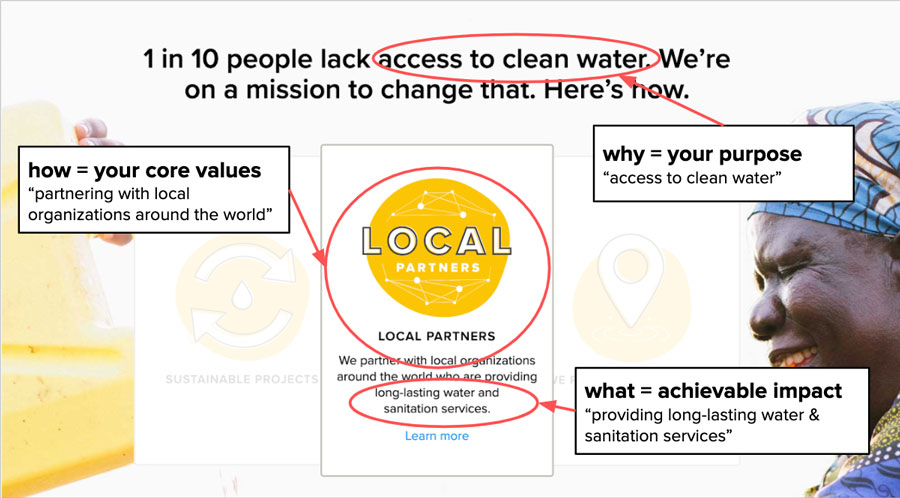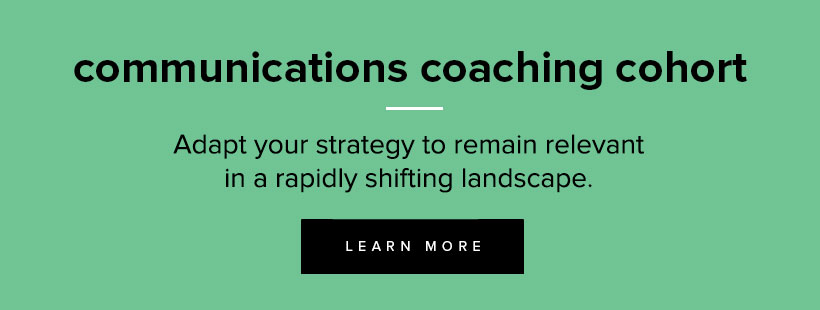Our nation, in the midst of crisis, has found itself at a crossroads. The direction we take from here—whether good or bad—will not only impact policy, but shape culture and affect generations to come. It all depends on the steps we take today.
That’s why it’s crucial for organizations to adapt and lead with a vision that breathes hope back into our communities, to convey a need that rallies everyone together.
How do you get there?
We can’t do it alone. As always, it will require our partners, staff, volunteers, community members, funders, donors and supporters to all rally around a cohesive vision. To build that momentum, we need to clearly communicate why our work is relevant and what impact we will have on shaping the future.
A communications strategy that delivers the right message > to the right person > at the right time > using the right methods.
Start with your core values.
If you’ve seen Simon Sinek’s now-famous TedTalk, you may be familiar with the Golden Circle. If not, here’s a quick way to approach the framework. Ask:
Why does your organization exist? What is your purpose?
Think about your values, the heart of your mission, why you do what you do—lead with your purpose.
How are you uniquely positioned, how are your values put into action?
In other words, what sets you apart from other organizations? What is it about the approach you take, the expertise of your staff, or the strategic partnerships you have formed that sets your work apart from others in the space?
No matter what, now is the time to showcase how your organization puts your values to work and how that work is critical to shaping the future.
What specifically do you do? What achievable impact(s) are you having? Sometimes we call these your outputs.

If you’ve used our logic model guide, this part will be a breeze.
Consider the activities that your organization performs regularly to achieve your impact, ie. your outputs—the things you are doing regularly that are measurable.
Try this Exercise:
Download our “How, What, Why” document (Google Docs or Excel)
In a group, take 10-15 minutes and have each person answer the questions on the “How, What, Why” document on their own. Take time to answer
Come together and have everyone share their answers for one column at a time (first “why,” then “how,” then “what”).
After everyone has shared, identify key phrases or ideas that resonate for each question and move them into a shared document.
Take 10 minutes as a group to score how important your identified key values are.
- Take 10 minutes as a group to score how actualized each value is.
Share the concepts with your staff, board, and community.
These will be a core component in your messaging.
Here’s a great example from Charity Water.

Design with your community in mind.
Think about the core values and unique positioning you just established. How do they represent your community? How do they align with their interests?
Remember, not everyone will be motivated by the same things. Your community is composed of a diverse group of individuals that are motivated by different aspects of your work. When you’re communicating with an individual, you want to be sure that you’re framing your work based on what motivates them.
To do this, we recommend building constituent personas.
The exercise below is an abbreviated version of Rootid’s persona workshop, and can help you get started with your team.
Personas are a semi-fictional character that represents your ideal constituent. Building personas will help you deliver the right message to the right person at the right time.
Once you have built out your personas, you should share the outcomes with other people within your organization. This will allow your team to better understand the motivations of the individuals that they interface with on a daily basis.
Try this Exercise:
In a group, take 20 minutes to jot down the names of real individuals you work with regularly (directly or indirectly) at your organization. Try to come up with at least 3 people per category of audience you engage with.
If you’re working in-person, you can write them on Post-It Notes and stick them to the wall.
If you’re working remotely, try using an app like Miro.
Next, group individuals based on what motivates them about your work, ie. what gets them to engage with you. You should end up with 3-4 groups.
Each of these groupings represents a persona. Now that you have defined your personas motivations, expand the information that you know about that individual. Start by asking questions like: What information and content will be most important to deliver to this persona? What do you want this persona to do as part of their experience with you? Where do we commonly encounter this individual? What is the best way to communicate with them?
Over the years, we have found that most organizations have some combination of these persona archetypes.

Although every organization will have a unique set of personas that they interact with, we find that most organizations combine at least 2 of the archetypes to create the foundation of what is most motivating to their unique stakeholders.
Keep in mind that some audience members may seem to be more than one persona, and that is ok, how you want to categorize them is based on what their ‘primary’ motivations are. Do they care most about equity, impact data or your program offerings?
Stay relevant to the situation. Connect the dots.
Vulnerable communities have been disproportionately affected by COVID-19. The inequity that existed before the pandemic has been magnified and accelerated. It may seem obvious to you why your work in this space is relevant, but your messaging needs to connect the dots for everyone else.
How has the crisis affected those you serve?
Arm yourself with that information, and take the lead. Change the narrative, start the conversation. Do anything you can to forge the future you’ve envisioned. If you don’t step up, someone else will—and their agenda may go against everything you believe in.
The truth is that the outcomes of the COVID-19 pandemic are still very fluid. And, acting now means that you can help shape the future.
To do this, you need to make a clear case for why your work is relevant to our current situation while also drawing clear lines toward where we are going from here.
Try this Exercise:
- As a group, create two columns on a white board: Inequities that existed before COVID-19 and a column of how COVID-19 has accelerated and exacerbated those issues.
- As a group write a phrase for how your work is address these inequities through your work.
- Now review the Based on your identified personas from the exercise before list out the motivations of each persona. Each person on your team should take 10-15 minutes writing a sentence for each each persona that clearly connects the impact of your work to the problems you’re seeing as a result of COVID-19.
- Share as a group and distill the outcomes into a messaging doc that you can share with your team to use in marketing efforts.
Be a conduit for action.
Inaction is rarely a result of apathy. Sometimes it is hard to see how a problem that is so large could be impacted by one individual’s action.
Your organization and your mission can act as an organizing force and a catalyst for individuals to focus their energy. Furthermore, providing your supporters with a collective action gives them a chance to feel part of a larger solution.
Take the lead to provide them an outlet. Too often we immediately think about asking for donations, but think beyond that.
What is a direct action that your community can take to have an impact that will make a difference?
Try this Exercise to Engage Your Existing Community:
Reach out to ten of your most trusted community members and partners. Ask them about their current situation and how your organization can partner with them to make an impact (not donation related).
Those not currently in your community may now be moved to engage in the work you do. What’s something you can offer that will get their attention or start a conversation?
Try this Exercise to Find and Engage New Community Members:
With your colleagues, use the personas that you created earlier in this article. Take this process a step further by discussing as a group what can you offer these individuals as a valuable experience? How can you organically start a conversation with them? Where can you find them? Once you have this written out, consider building a campaign that can help bring these individuals into your organization.
Alter your campaign approach.
We’re currently living in a physically-distanced reality. How has that changed your normal marketing efforts? Have you adapted anything digitally?
Think about whom you’re approaching, and empathize with their current state – are they laid off? Are they financially strapped? Are they eager to help but don’t know how?
Here’s a great example…
Each year, American Rivers puts out there Most Endangered Rivers report. The report highlights 10 rivers that are endangered for a number of different reasons.
The report is one of their most important marketing campaigns of the year for American Rivers. It generates huge awareness for their work. In the past, much of this success has been driven by PR and getting earned media hits.
This March, as COVID-19 was starting to impact communities around the United States, the American Rivers team realized that news outlets, who they traditionally relied on to get word out about the report, were being hit by massive layoffs. It was unlikely that MER would get the traction it normally did.
As a result, they made a major pivot in their campaign approach that generated that largest response to their report ever.
Rather than relying on national news outlets, American Rivers pivoted their focus to work with local coalitions and partners as their main marketing channel. They prepared social media kits and marketing materials that partners and local coalitions could use to promote the campaign.
By understanding how the marketing environment had shifted, and evaluating what assets and relationships they had, American Rivers was able to successfully break through the COVID-19 noise and engage more constituents than ever before.
You can read more details about their success here.
Try this Exercise:
With your team, review the key campaigns you have coming up this year and ask these questions for each:
- What are the main drivers of success?
- Can you still rely on those drivers to succeed?
- What physical materials will need to be moved to a digital format?
- What advantages can you get from going digital?
- Are there existing digital assets that can be repurposed?
- What assets need to be created?
Put it in action.
As the Liberatory Design process teaches us, “Build to think and learn.” By embracing an experimental mindset, you can let go of perfection and adapt your communications strategy as you take action and learn. If you do not begin prototyping and testing, you’ll remain right where you started. Get out there and begin making your vision a reality! The world is counting on us.


